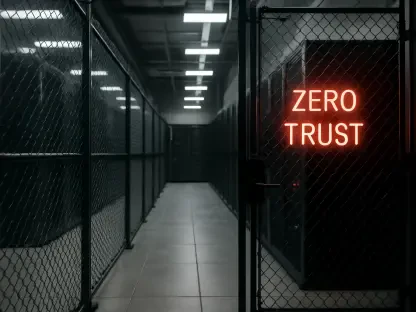In an era where digital transformation is accelerating at an unprecedented pace, the convergence of artificial intelligence (AI) and cybersecurity has emerged as a defining frontier for protecting sensitive data and critical systems from ever-evolving threats. AI holds immense promise for revolutionizing security practices with its ability to predict threats and automate responses, yet it simultaneously opens new avenues for exploitation by cybercriminals through sophisticated attacks on data and algorithms. As businesses and governments increasingly rely on AI for decision-making and operational efficiency, the urgency to secure these systems against evolving risks cannot be overstated. Zero Trust, a security paradigm rooted in the principle of “never trust, always verify,” offers a compelling solution to safeguard AI-driven environments. This article delves into the symbiotic relationship between AI and Zero Trust, exploring how they complement each other to create a fortified defense against modern cyber threats while addressing the challenges of implementation in a rapidly changing landscape.
The Double-Edged Sword of AI in Security
The integration of AI into cybersecurity strategies represents a transformative shift, providing organizations with powerful tools to stay ahead of potential threats in a complex digital world. AI’s capabilities, such as predictive analytics and real-time anomaly detection, enable security teams to identify and neutralize risks before they escalate into full-blown breaches. By processing vast amounts of data at lightning speed, AI can uncover patterns that human analysts might overlook, making it an invaluable asset for enhancing threat intelligence. However, this strength comes with a significant caveat: the same data-intensive systems that fuel AI’s effectiveness also make it a prime target for malicious actors. Cybercriminals are increasingly exploiting vulnerabilities through methods like data poisoning, where tainted inputs corrupt AI models, or model inversion, which reverse-engineers sensitive information. These threats underscore the limitations of outdated, perimeter-based defenses that fail to address the nuanced risks posed by AI, highlighting the need for a more robust security approach.
While AI’s potential to revolutionize cybersecurity is undeniable, its vulnerabilities expose organizations to unprecedented risks that demand immediate attention and innovative solutions. Traditional security models, which often assume trust within internal networks, are ill-equipped to handle the sophisticated attacks targeting AI systems today. For instance, adversaries can manipulate training datasets to skew AI outputs, leading to catastrophic decisions in critical applications like autonomous vehicles or financial systems. Moreover, the sheer volume of data processed by AI creates a treasure trove for hackers seeking to extract proprietary or personal information through breaches. As reliance on AI grows across industries, the attack surface expands, making it imperative to adopt frameworks that prioritize constant vigilance over blind trust. This evolving threat landscape sets the stage for Zero Trust to emerge as a critical safeguard, ensuring that AI’s benefits are not undermined by its inherent weaknesses and providing a structured defense against exploitation.
Zero Trust: A Robust Barrier for AI Systems
Zero Trust reimagines cybersecurity by rejecting the notion of inherent trust, instead requiring continuous verification for every user, device, and process, regardless of their location within or outside the network. For AI systems, which handle sensitive data and underpin critical operations, Zero Trust offers a vital layer of protection through principles like micro-segmentation and least privilege access. Micro-segmentation isolates components of AI workflows, such as separating training data from production environments, to limit the spread of a breach if one occurs. Similarly, least privilege ensures that only authorized entities gain access to specific resources, reducing the risk of unauthorized tampering with AI models. Insights from major industry gatherings reveal a growing consensus that Zero Trust is indispensable for securing AI against modern threats, as it addresses gaps left by traditional defenses and fortifies systems at a granular level.
Implementing Zero Trust to protect AI is not merely a reactive measure but a proactive strategy to contain and mitigate risks before they spiral into larger crises. By enforcing strict identity-based access protocols, organizations can prevent malicious actors from exploiting vulnerabilities in AI algorithms or datasets, even if they gain initial entry into a network. This approach is particularly crucial for industries like healthcare or finance, where AI-driven decisions impact lives and economies, and a single breach could have devastating consequences. Furthermore, Zero Trust’s emphasis on continuous monitoring allows for real-time detection of anomalies that might indicate an attack, such as unusual access patterns targeting AI infrastructure. As cyber threats grow in sophistication, adopting Zero Trust becomes a foundational step to ensure that AI systems remain secure and reliable, preserving trust in their outputs while safeguarding the integrity of the broader digital ecosystem against persistent and evolving dangers.
Enhancing Zero Trust with AI Capabilities
AI serves as a powerful enhancer of Zero Trust architectures, bringing automation and intelligence to security protocols that were once heavily reliant on manual oversight. Through advanced machine learning algorithms, AI can analyze user behaviors and network traffic in real time, identifying deviations that signal potential threats and dynamically adjusting access privileges accordingly. This capability is particularly valuable in Zero Trust environments, where constant verification is paramount, as it minimizes human error and accelerates response times. Tools powered by AI, such as extended detection and response (XDR) systems and identity and access management (IAM) platforms, integrate seamlessly into Zero Trust frameworks, providing a layered defense that adapts to risks as they emerge. This synergy enables organizations to tackle complex challenges like deepfake attacks or ransomware with greater precision and efficiency.
Beyond automation, AI’s predictive capabilities elevate Zero Trust by anticipating threats before they materialize, creating a more proactive security posture. For instance, AI can assess historical data alongside current trends to forecast potential attack vectors, allowing systems to preemptively tighten controls in high-risk scenarios, such as during a surge in remote work. This adaptability is crucial in today’s dynamic threat environment, where adversaries continuously refine their tactics to bypass static defenses. By embedding AI into Zero Trust models, cybersecurity becomes not just a barrier but an intelligent, responsive mechanism that evolves with the threat landscape. Reports from industry leaders indicate that this integration significantly strengthens defenses against emerging risks, ensuring that verification processes remain robust while enabling scalability across diverse and distributed networks, thus fortifying the overall resilience of organizational security.
Navigating Challenges and Future Directions
Integrating Zero Trust with AI systems presents a host of challenges that organizations must address to fully realize the potential of this dual defense mechanism. Data silos and legacy infrastructure often hinder seamless adoption, as older systems may not support the granular controls required by Zero Trust or the computational demands of AI. Additionally, the financial burden of upgrading technology and training staff can be substantial, particularly for smaller enterprises. Overly restrictive Zero Trust policies risk stifling innovation by limiting access to AI tools, creating a tension between security and operational agility. Privacy concerns also loom large, as AI’s reliance on vast datasets raises questions about data handling and compliance with regulations. These obstacles necessitate a balanced approach that prioritizes both robust protection and the flexibility needed to drive technological advancement.
Looking ahead, the path to effective integration lies in developing scalable, hybrid models that combine AI’s predictive strengths with Zero Trust’s strict verification protocols to build enduring cybersecurity frameworks. Strategic investments in infrastructure modernization are essential to overcome barriers like outdated systems, while fostering collaboration between security and innovation teams can help strike the right balance between control and creativity. Industry discussions on platforms like X also point to emerging solutions, such as using game theory to design automated defenses against specific AI vulnerabilities like prompt injection attacks. As projections suggest that a significant majority of firms will embed AI into Zero Trust strategies by 2027, the focus must shift to creating adaptive systems capable of withstanding both current and future threats. This forward-thinking approach ensures that the digital landscape remains secure, leveraging the combined power of AI and Zero Trust to address the complexities of an ever-evolving cyber environment.









